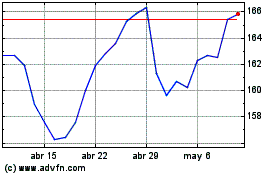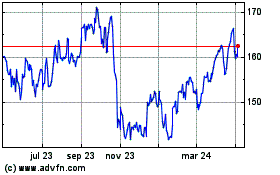Chevron CIO Says Technology Triggers Faster Human Decisions
29 Enero 2019 - 6:57PM
Noticias Dow Jones
By Sara Castellanos
Energy giant Chevron Corp. is among the many companies across
industries that are feeling pressure to innovate rapidly.
Chief Innovation Officer Bill Braun says that's causing the
nature of his job to change.
In addition to overseeing information technology for the
company's nearly 52,000 employees, he's working to assess and
validate cutting-edge technology through partnerships with
Chevron's venture-capital fund and other large technology
companies. He also works with a technology advisory board that
governs Chevron's total technology spending.
"The nimbleness and speed at which we need to be able to move is
much more compressed," said Mr. Braun, who joined the San Ramon,
Calif., company as a programmer in 1991 and has served as CIO since
2015. "It's really critical that we're able to react faster."
New technologies such as advanced sensors, artificial
intelligence, quantum computing and virtual and augmented reality
are flooding into the market at a rapid pace, and at the same time,
large companies are realizing they can't innovate alone.
Chevron joins other enterprises such as JetBlue Airways Corp.,
Walmart Inc. and SAP SE that are establishing formal processes for
working with startups. Their respective technology executives are
becoming deeply involved in evaluating new ideas.
As CIO, Mr. Braun said he never expected to be so closely
involved with certain cutting-edge technology deployments, such as
facial recognition technology that Chevron is beginning to use in
trucks to help detect fatigue in drivers. He's also working much
closer with other technology vendors on initiatives that could have
significant financial payoffs within the next few years.
For example, with Mr. Braun's involvement, Chevron launched an
effort to predict maintenance problems in its oil fields and
refineries using Internet of Things services from Microsoft Corp.
He's involved in helping set priorities for the deal and making
sure the companies are jointly "pushing the envelope in how we're
trying to apply technology," he said.
Mr. Braun is excited about advancements in technologies that
could, for example, help make predictive maintenance more
effective. Chevron is doing 700 less inspections on pressure valves
annually, in part because emerging technologies such as data
analytics, sensors and machine learning have become so advanced and
accurate at predicting equipment failures, he said. That technology
also helps prevent the need for dangerous manual inspections, he
said.
Fiber optic cables also have gotten on his radar, but not for
purposes of telecommunication. Chevron is experimenting with the
use of the cables, which are sensitive to sound waves, pressure and
temperature, and could be used in oil wells to detect leaks. They
also could be placed along an oil pipeline to help better detect
incoming trucks or footsteps for security reasons.
Mr. Braun said he also must work closely with small startups
that could eventually have scalable technology deployments under
his purview.
That is where Chevron Technology Ventures comes into play -- a
corporate venture fund that has invested $325 million in about 80
startups over two decades. "We have to be much closer to some of
these smaller, faster companies," Mr. Braun said.
Chevron's use of biofuels, which are produced through processes
involving biology rather than geology, originated from the venture
group.
Although the venture fund isn't new, the rapidly changing pace
of technology and the competitive technology landscape is resulting
in faster timelines for evaluating and testing new ideas, said
Barbara Burger, who has been president of Chevron's venture unit
since 2013.
It takes days for the division to become aware of a startup and
to begin evaluating their technology, as opposed to weeks and
months in years past, Ms. Burger said.
"The pace and amount of innovation, and the abundance of
information about innovation has increased dramatically," she
said.
The venture arm is interested in pursuing startups that offer
technology to help increase oil-and-gas production, and materials
that could result in stronger, lightweight equipment. Last year, it
also announced a new venture fund with an initial $100 million to
invest in technologies that could lower emissions from oil-and-gas
operations and technologies that help produce lower carbon energy
sources.
Emerging technologies that might take several years to come to
fruition, such as quantum computing, are also on Chevron's
radar.
"It holds a lot of promise, but you measure it on a different
time scale than you would some of the others," Mr. Braun said.
Write to Sara Castellanos at sara.castellanos@wsj.com
(END) Dow Jones Newswires
January 29, 2019 19:42 ET (00:42 GMT)
Copyright (c) 2019 Dow Jones & Company, Inc.
Chevron (NYSE:CVX)
Gráfica de Acción Histórica
De Abr 2024 a May 2024

Chevron (NYSE:CVX)
Gráfica de Acción Histórica
De May 2023 a May 2024
